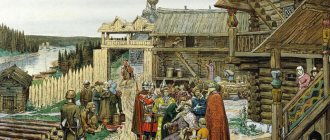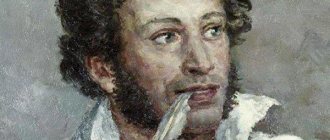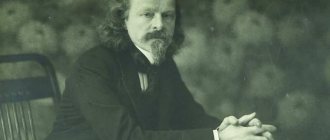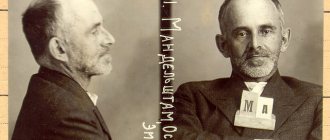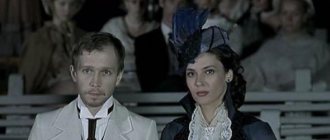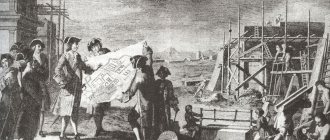Description of the monument
The monument on Senate Square in St. Petersburg depicts Peter I sitting on a rearing horse. He stands on top of a rock pedestal, and at the horse’s feet lies a defeated snake. All this symbolizes the difficulties and hostile forces overcome by the emperor.
The snake serves as one of the support points for the imperial horse, which is a rather original solution for giving the sculpture stability.
Peter's gaze is directed forward. According to the author of the sculpture, “he extends his beneficent right hand” to all the territories where he passes. At the same time, the autocrat does not have symbols of state power in his hands and he is dressed not in military armor, but in simple clothes. In the sculpture, Peter I appears not as a commander, but as a legislator, educator, creator and benefactor.
However, there is still a hint of statehood and the victories of the autocrat in the monument. The head of Peter I is decorated with a laurel wreath, and a sword hangs from his belt .
On the pedestal there is an inscription in Russian and Latin - “Catherine II to Peter I, Summer 1782.” It perpetuates the name of the empress and emphasizes her commitment to Peter's reforms.
The Bronze Horseman monument is surrounded by a low fence along which shrubs and flowers are planted.
History of creation
The French sculptor Etienne Falconet, who was working at a porcelain factory at that time, was invited to work.
His candidacy was proposed to the Empress by Denis Diderot. “He has an abyss of subtle taste, intelligence and delicacy, and at the same time he is uncouth, stern, and does not believe in anything. He does not know self-interest,” the philosopher wrote about Falcon. Having received the invitation, the sculptor immediately agreed; he had always dreamed of monumental art. Falcone decided to present Peter I as “the creator, legislator and benefactor of his country.” “My king does not hold any rod, he extends his beneficent right hand over the country he travels around. He rises to the top of the rock that serves as his pedestal - this is an emblem of the difficulties he has overcome.”
To create an accurate model, the sculptor ordered to build a platform with the same slope that the pedestal was supposed to have. Falconet made sketches, watching how the guards officer flew up on his horse onto the platform and reared it. The head of Peter I was sculpted by Falconet's student Marie-Anne Collot. The sculptor took on this work three times, but each time Catherine II rejected it. As a result, Marie proposed her sketch, which was approved by the empress. For this work, the girl was accepted as a member of the Russian Academy of Arts, Catherine II assigned her a lifelong pension of 10,000 livres. The snake under the horse’s feet - a symbol of evil forces and the victory of Peter I over the opponents of his reforms, as well as being the third fulcrum of the horse - was made by the Russian sculptor Fyodor Gordeev.
The Academy of Arts began searching for the monolith stone when the model of the monument was not yet ready. In modern terms, a competition was announced to find a stone for the pedestal, and the newspaper St. Petersburg Vedomosti published an advertisement. The stone was found twelve miles from St. Petersburg by the peasant Semyon Grigorievich Vishnyakov. For this find he was awarded a prize of 100 rubles. The granite rock broken by lightning was named "Thunder Stone". It went more than 4 m into the ground and was all covered with moss. The monolith weighed about 1600 tons. Transportation of the stone took about six months; first, it was dragged on a special platform all winter to the Gulf of Finland, and then transported by ship.
The giant “Thunder Stone”, with a huge crowd of people, arrived in St. Petersburg on Senate Square on September 26, 1770. At that time it was a wasteland; there was neither the Senate building nor St. Isaac's Cathedral. Starting from 1775, work was carried out to cast the monument. Etienne Falconet was unable to complete the monument himself; Yu.M. completed the job. Felton and F.G. Gordeev.
The grand opening of the monument with a military parade took place on August 7, 1782, on the day of the 100th anniversary of Peter I’s accession to the Russian throne. The signal for the opening was given by the empress herself.
Why is the monument called the Bronze Horseman?
The question of the Bronze Horseman is especially relevant in light of the fact that the monument to Peter I in St. Petersburg is cast in bronze. But the answer is quite simple.
The monument became “copper” because of Pushkin’s work of the same name, in which the emperor on his horse jumps off the monument and rushes after the official Eugene, who lost his beloved during the flood.
Interesting fact! The image of Peter on horseback was used in their works by F. Dostoevsky and A. Bely. The reference leads specifically to the monument on Senate Square.
Bronze Horseman analysis
The Bronze Horseman analysis of the work briefly
1. History of creation . The plot of the poem “The Bronze Horseman” is based on a real event - the terrible St. Petersburg flood of 1824.
The work was written by A. S. Pushkin in October 1833 in Boldino.
During the poet’s lifetime, only the “Introduction” was published, from which some fragments were excluded due to censorship requirements.
The Bronze Horseman was published in its entirety by Zhukovsky after Pushkin’s death in 1837. This publication was also subject to censorship distortions. In particular, the word "idol" was replaced with "giant"; the description of the monument and the protagonist's rebellion was cut out.
2. The meaning of the name . The Bronze Horseman is a monument to Peter I in St. Petersburg, a symbol of unlimited monarchical power, irresistible force, power and greatness.
3. Genre . Poem
4. Theme . The central theme of the poem is the initially doomed confrontation between the “little man” and the powerful elements. The main character, the poor poet Evgeniy, dreams of a simple and happy life with his beloved girl, Parasha. All his hopes crumble to dust during a natural disaster - an unprecedented flood.
Unable to get to the other side of the Neva, Evgeny watches in horror as his beloved’s house gradually disappears behind the menacing waves. A silent witness to the tragedy is the monument to Peter I, which sinks into the consciousness of the poet. After the water recedes, Evgeniy does not find Parasha’s house in its original place. This irreparable misfortune is driving him crazy.
Eugene wanders around the city for a long time until he randomly finds himself again at the foot of the Bronze Horseman. In anger, he dares to rebel against the giant: “Good, miraculous builder!” Already for you!..” It seems to the unfortunate poet that the monument is beginning to haunt him. Evgeny finally goes crazy and dies at the threshold of his beloved’s “ramshackle house” that accidentally washed up on the shore. The images of the flood and Peter I merge together in Eugene’s soul.
The natural elements and the activities of the reformer king are part of one brute and cruel force that mercilessly crushes people under itself. Only irreparable loss and clouding of reason make Eugene dare to speak out against the inevitability. The fantastic pursuit of the Bronze Horseman symbolizes the inevitable punishment for the rebel, who can only admit his defeat.
5. Issues . The main problem of the poem is the unlimited power of the monarch. Peter I boldly embarked on the most radical reforms. St. Petersburg became the adornment of the Russian Empire, but its foundation was bought at too high a price. Peter I deliberately founded the city in an empty and completely inappropriate place. This resulted in numerous casualties, both during construction and subsequently.
In the poem, Alexander I admits: “Tsars cannot cope with God’s elements.” The “Introduction” expresses the author's subtle irony. The scale of the activities of Peter I is amazing, but it would seem that the “defeated element” could reassert itself and lead to the death of a large number of “little people.” At the same time, the Bronze Horseman remains unshakable and indifferent to human suffering.
6. Heroes . Evgeny, Bronze Horseman
7. Composition . The poem consists of three parts: an introduction, a description of the flood and its consequences.
8. What the author teaches. It was not for nothing that the censorship subjected the poem to distortions. Pushkin drew a direct parallel between autocracy and blind elements. The image of Eugene contains a prophetic hint of the future real revolutionary rebellion of the “little people.”
Authors of the monument
For some reason, many consider Etienne Falconet, a French sculptor, to be the only author of the monument to Peter the Great in St. Petersburg. In fact, this is not entirely true, although he also completed a large amount of work.
A fairly responsible part of them was taken on by a student of the French master, Marie Anne Collot. She sculpted the head of the sculpture. The work was entrusted to Marie after Catherine II three times rejected E. Falconet’s options. The sketch of his student, on the contrary, pleased the empress, who eventually awarded the girl a lifelong pension and accepted her into the Russian Academy of Arts.
The snake at the horse’s feet was sculpted by F. Gordeev, the casting of the main part of the statue was supervised by V. Ekimov, and the architectural and planning solution was handled by Y. Felten.
The history of the creation of the Bronze Horseman
The history of the creation of the Bronze Horseman is full of contradictions and even conflicts. And if not for E. Falcone, Senate Square could have been decorated with a completely different sculpture.
Project work
Prominent minds of Russian academies could not decide on the type of monument for a long time. Catherine II wanted to see him majestic and on a horse, Belsky - without a horse, Diderot proposed making a monument to Peter I in St. Petersburg in the form of a fountain. Shtelin saw the emperor not alone, but among the human vices who had fallen at his feet, embodied in metal.
Falcone decisively abandoned his original ideas and created a sketch of the monument that it appears today.
Interesting fact! To create a dynamic sculpture, Falcone made sketches from a moving horse. To do this, the guards officers raised the horse on its hind legs and held it in this position or soared on it along the platform.
Pedestal "Thunder Stone"
The sculpture of Peter I stands on an impressive pedestal - a hewn block of stone. They searched for her all over the outskirts of St. Petersburg, and an ad was even published in the local newspaper asking citizens to help in the search.
As a result, the peasant S.G. Vishnyakov found a suitable block, for which he received a bonus of 100 rubles. The granite block, split by a lightning strike, was popularly called the “Thunder Stone”.
The “Thunder Stone” weighed 1,600 tons , was buried almost 4 m into the ground and covered with moss. When it was removed, a large pit formed in this place, quickly filling with water. This reservoir has survived to this day and is called “Petrovsky Pond”.
Transporting such stone was particularly difficult. To deliver it to the Gulf of Finland, it was necessary to build trenches along the entire route and place large copper balls in them. The block was moved along them. The work was carried out in winter so that the frozen soil could withstand a greater load. A specially built barge was waiting for the stone in the bay.
Transporting the block required the efforts of more than 1,000 people and about six months of time. The stone arrived at Senate Square on September 26, 1770. A huge number of people watched its unloading.
Before installation, the stone was well hewn, and it lost most of its dimensions and splendor.
Casting and installation of the monument
The casting of the monument to Peter I in St. Petersburg caused many problems for Falcone. He himself had never performed such work, and there was not a single workshop in the city where they could cast a monument in such dimensions. No one could guarantee the success of the enterprise or promise the desired result.
The French specialist B. Ersman was invited to cast the sculpture. He arrived with assistants and even all the necessary materials. But fruitful cooperation with Russian sculptors and artists did not work out. Ersman was fired at the insistence of Yu. Felten.
His place was taken by E. Khailov, who had previously been engaged in casting cannons . He had to select a new composition for casting so that the monument would stand on only three points of support, making it strong but light.
The first casting attempt was unsuccessful. The pipe through which bronze was supplied to the mold burst. Having almost died, Khailov was able to prevent a fire in a wooden workshop. The second casting attempt, which followed only 3 years later, was crowned with success.
In the midst of his work, the relationship between the sculptor Falcone and Catherine II rapidly deteriorated and in 1778 he was forced to leave Russia. The master took with him all the drawings, sketches, as well as his talented assistant Marie Anne Collot. In this regard, further work on completing the sculpture and its installation was supervised by J. Felten.
The monument to Peter I or the Bronze Horseman was erected on Senate Square in St. Petersburg in 1782 . In honor of this, a military parade was held under the leadership of D. A. Golitsyn.
The Bronze Horseman - history of creation
The initiative to create a monument to Peter I belongs to Catherine II. It was on her orders that Prince Alexander Mikhailovich Golitsyn turned to the professors of the Paris Academy of Painting and Sculpture Diderot and Voltaire, whose opinion Catherine II completely trusted. Famous masters recommended Etienne-Maurice Falconet, who was working at that time as the main porcelain sculptor, for this work,” Diderot wrote about Falconet.
Etienne-Maurice Falconet always dreamed of monumental art, and having received an offer to create an equestrian statue of colossal size, he agreed without hesitation. On September 6, 1766, he signed a contract in which the remuneration for the work was set at 200 thousand livres, which was a fairly modest amount - other masters asked for much more. The 50-year-old master came to Russia with his 17-year-old assistant Marie-Anne Collot.
Opinions about the appearance of the future sculpture were very different. Thus, the President of the Imperial Academy of Arts, Ivan Ivanovich Belskoy, who supervised the creation of the monument, presented a sculpture of Peter I, standing at full height with a staff in his hand. Catherine II saw the emperor sitting on a horse with a staff or scepter, and there were other proposals. Thus, Diderot conceived a monument in the form of a fountain with allegorical figures, and State Councilor Shtelin sent Belsky a detailed description of his project, according to which Peter I was to appear surrounded by allegorical statues of Prudence and Diligence, Justice and Victory, which support the vices Ignorance and Laziness with their feet, Deception and Envy. Falcone rejected the traditional image of a victorious monarch and abandoned the depiction of allegories. “My monument will be simple. There will be no Barbarism, no Love of peoples, no personification of the People... I will limit myself only to the statue of this hero, whom I do not interpret either as a great commander or as a winner, although he, of course, was both. The personality of the creator, legislator, benefactor of his country is much higher, and this is what needs to be shown to people,” he wrote to Diderot.
Interesting facts about the Bronze Horseman
- The “Thunder Stone” took almost a year to be removed from the ground.
- The stallions from which Falcone made the sketch were called Diamond and Caprice.
- Falconet was promised 200,000 livres for work on the sculpture.
- In honor of the opening of the sculpture, commemorative silver coins were issued. Three gold coins were issued for those involved in its creation, one of which Catherine II sent to Falcone. However, he was not invited to the opening of the monument.
- On the cloak of Peter I there is an inscription stating that Etienne Falconet worked on the sculpture.
- During World War II, the monument was boarded up and covered with sandbags to protect it from destruction.
- During the restoration of the monument in 1976, a capsule with a document on the restoration and a newspaper dated September 3 of the same year was placed inside it.
- The height of the monument is about 5 m.
The Bronze Horseman, with its rich history and majestic appearance, has long become one of the symbols of St. Petersburg. Both tourists and city residents enjoy taking pictures against its background. A rearing horse with a rider so significant for the history of Russia is interesting for both adults and children.
Interesting facts about the Bronze Horseman monument
- Transportation of the stone pedestal was accompanied by difficulties and unforeseen circumstances, and emergency situations often occurred. The whole of Europe followed that operation, and in honor of the delivery of the Thunder Stone to Senate Square, a commemorative medal was issued with the inscription “Like daring. Genvarya, 20, 1770"
- Falconet conceived a monument without a fence, although the fence was still installed, but has not survived to this day. Now there are people who leave inscriptions on the monument and damage the pedestal and the Bronze Horseman. It is possible that a fence will soon be installed around the Bronze Horseman
- In 1909 and 1976, restoration of the Bronze Horseman was carried out. The latest examination, carried out using gamma rays, showed that the sculpture's frame is in good condition. Inside the monument was placed a capsule with a note about the restoration carried out and a newspaper dated September 3, 1976
The Bronze Horseman in St. Petersburg is the main symbol of the Northern capital, and newlyweds and numerous tourists come to Senate Square to admire one of the most famous sights of the city.
